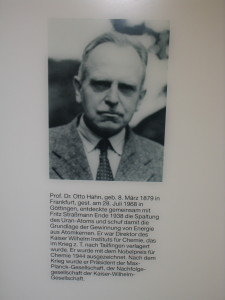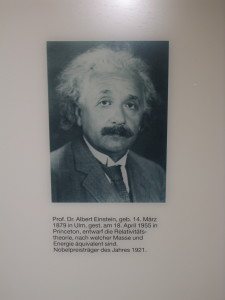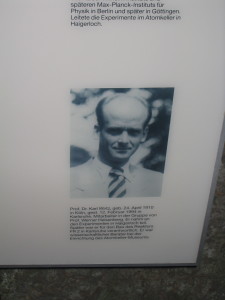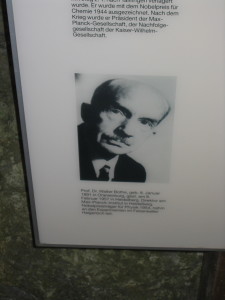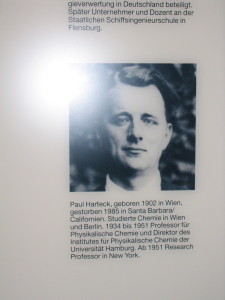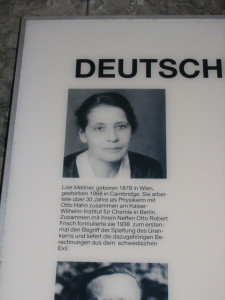Robert Oppenheimer, physics professor from the University of California, Berkley is widely recognized as the “father of the atomic bomb”.
Interviewed after the war and asked about his thoughts upon seeing the results of the first atom bomb test in Alamogordo, New Mexico, Oppenheimer would remark that his first thought was of Hindu scripture, the Bhagavad-Gita; Vishnu is trying to persuade the Prince that he should do his duty, and to impress him, takes on his multi-armed form and says, “Now I am become Death, The destroyer of worlds”.
You can see a portion of the interview here.
https://www.youtube.com/watch?v=26YLehuMydo
What is clear from watching the interview is that Oppenheimer was deeply troubled by the invention of the atomic bomb. Dozens of books have been written about how many of the Manhattan Project scientists came to regret their efforts to deliver a working device. But all of them were petrified at the idea that the Nazis would beat them to it. This is what motivated them to work day and night to deliver a working device to the US Army.
Had history unfolded in a different way, it could very well have been someone in Germany being interviewed after the war and not Oppenheimer. Imagine for a moment a recording of a speech by Goebbels with him screaming (for he always seems to be screaming) about Hitler’s use of the bomb on New York City or Chicago or both. Its not so farfetched.
In the 1920’s and 1930’s most of the experimental physics that led to the theory of how to build a bomb was happening in Germany. Furthermore, most of the key physicists, chemists, and mathematicians who would build the bomb in the 1940’s were living in Europe, many working in Germany at the Keiser Wilhelm Institute or at various universities around Germany including the Institute of Technology, Humboldt University and the Berlin Academy of Sciences..
It was only due to the increasing anti-Semitism of the Nazi government that forced many key scientists to flee Germany for America. These scientists were either Jewish themselves or were married to Jewish women. Either way, the Nazi Nuremberg Laws implemented as the Nazis came to power in 1933, forced all of them out of their positions at universities in Germany.
Which reminds me of a good joke. … Why are there so many famous Jewish violinists and not so many famous Jewish pianists?
Have you considered how hard it is to flee while carrying a baby grand piano?
Among the first to leave was Einstein who left Germany almost coincident with Hitler’s rise to power in 1933. But many, many others were to follow. None more important than the four Hungarians below:
Leo Szilard: Szilard conceived the nuclear chain reaction and patented the idea in 1933 with Enrico Fermi (keep reading). He had been in London listening to a speech by Ernest Rutherford where Rutherford had rejected the feasibility of using atomic energy for anything useful. In reaction to Rutherford, Szilard had an epiphany which eventually led to his and Fermi’s selection of Uranium as the element most capable of sustaining a chain reaction.
No one scientist is more responsible for the American bomb than Szilard. He was so worried about a Nazi bomb that he drafted a letter to President Roosevelt in 1939, warning Roosevelt of the danger of a Nazi bomb and encouraging the Allied effort to create a bomb before the Nazi’s got one. Szilard contacted Albert Einstein and convinced him to sign the letter as he knew that Einstein’s name carrier much more weight than his own.
Szilard would join Enrico Fermi in Chicago where they built the first atomic reactor or “pile” as they called it, “safely” tucked beneath the bleachers at Stagg Field at the University of Chicago.
Eugene Wigner: Wigner was the actual physicist who introduced Szilard to Einstein. The story goes that even after immigrating to the US, he refused to have his fingerprints taken for fear that the Nazis might beat the Allies to a bomb, win the war, and then track him down and kill him. Wigner’s job on the Manhattan Project was to design and run the nuclear reactors that would convert uranium to weapons grade plutonium. These reactors were built at Hanford in Washington State along the Columbia River. The plutonium from Hanford was used in the devices at the Trinity Site as well as for the “Fat Man” bomb which was dropped on Nagasaki.
Edward Teller: Teller joined the Manhattan Project to assist in the design of the bomb. But Teller was a proponent of a nuclear fusion bomb (instead of fission) which today is known as the more powerful hydrogen bomb. During the war, Oppenheimer wanted to shelve all work on the H-Bomb in favor of getting a fision bomb working. But Teller kept pushing for it and became furious with the other Manhattan Project scientists when they would not support him. He was passed over for a promotion to become the director of the theoretical division (Oppenheimer picked Hans Bethe instead) at which point Teller became totally uncooperative. He refused to work on the calculations for the implosion mechanism for the plutonium fission bomb. He eventually went on to co-found the Lawrence-Livermore Laboratories where he would design the worlds first Hydrogen bomb.
John von Neumann: von Neumann was one of the world’s finest mathematicians. His contribution to the Manhattan Project was that he had become the leading expert on the mathematics of shaped charges. His idea was that the power of the atomic explosion would be greatly enhanced through the design of a “explosive lens” that focused the force of the shaped charge to compress the nuclear material with extraordinary force to create the nuclear explosion. This design was critical for the plutonium devices at Trinity and the “Fat Man” bomb at Nagasaki. And the plutonium bombs became even more important when production of enriched uranium (keep reading) was delayed and it became obvious that there would only be enough for one device (used at Hiroshima “Little Boy”.
This shaped charge idea explains why “Fat Man” was big and round and looked a bit like a soccer ball. The inner par was a lump of plutonium. When the plates on the outside of the ball exploded, they acted to compress of lump of plutonium at such a high speed and at such a high force that a nuclear chain reaction was initiated and fission occurred.
von Neumann’s calculations also showed that the bomb would be far more devastating if it were to explode above the ground rather than upon impact. This led to the need for an altitude trigger, since all bombs to this point just had a detonator that fired when it impacted with the ground.
In addition to the Hungarians, a large number of other physicists from other European countries joined the ranks of the Manhattan Project after losing their positions due to the Nazi Nuremberg Laws prohibiting Jews from positions at German universities.
These included:
Enrico Fermi: Fermi led the team that designed the reactor that they called Chicago Pile-1 which first went critical on December 2, 1942. This was the first demonstration of a self-sustaining nuclear chain reaction. He was involved at both Hanford where uranium was being trans mutated into plutonium. A slug of U-238 was bombarded with neutrons to form U-239 which has a short half-life and decays quickly to plutonium-239. The plutonium-239 was then separated from the slug of uranium and was then ready for use in a bomb. The design of the reactor was such that fresh slugs of U-238 would enter one side of the reactor while an enriched P-239 slug would come out the other side. Thus the reactor never had to be shut down as it continuously created P-239 enriched slugs.
Fermi also was involved at Oak Ridge Tennessee where bomb grade U-235 was separated out from the naturally occurring U-238. The problem is that the fissile U-235 represents only .72% of natural uranium and the weight difference between the 2 is only 1.6%. So its complicated to separate the 2 materials. Oak Ridge used a gaseous diffusion process that yielded only small amounts of enriched U-235. The shortage was so severe that the plutonium from Hanford became the material of choice.
However the design for an exploding device made from U-235 was much more simple than one made from plutonium-239. In the case of U-235, you just needed the barrel of a cannon and 2 masses of U-235 at either end. Each mass was smaller than the mass needed to sustain a nuclear reaction. To explode the device, you simply needed to fire the cannon sending one mass of U-235 slamming into the other mass. This design was used for the device that exploded over Hiroshima (“Little Boy”). It was long and skinny. Inside was an actual gun barrel.
Stanislaw Ulam: Ulam was a Polish born mathematician recruited into the Manhattan Project to work with Hans Bethe in the Theoretical Division. His job was to help design the shaped charges that would become part of the device known as “Fat Man”. But when Ulam arrived at Los Alamos in February 1944, the Manhattan Project was deep trouble. Emilio Segre (keep reading) figured out that the plutonium made in the Hanford reactors would not work in a gun-type plutonium device which was the design of choice up to that time. This device was called “Thin Man” and it was being developed in parallel with “Little Boy”, the U-235 version of the same thing. But Segre figured out that the plutonium version would not work. The crisis now created was to either stop all work at Hanford and redesign the reactors so that the output would be more U-235 which meant duplicating the cost and time associated with building another site like Oak Ridge, Tennessee but in Washington State.
Or, alternatively, the second option was to abandon the “Thin Man” design and go with the “Fat Man” design. Oppenheimer rolled the dice and focused all development on the shaped charge focused implosion idea (the big round soccer ball).
Ulam and von Neumann worked out the math to make the focused implosion idea work.
Hans Bethe: Bethe successfully ran the largest department at Los Alamos, the Theoretical Division which oversaw the development of the design concepts for Fat Man and Little Boy. Bethe famously spoke out at a critical moment when the Los Alamos scientists began to have second thoughts about dropping the bomb on a populated city. Bethe pointed out that that his only wish was that they had delivered the bomb a year earlier so that it could have been used on Nazi Germany.
Emilio Segre: Segre joined the Manhattan Project in late 1942 at Los Alamos. His job was to precisely measure the radioactivity of various fissile materials. When the group received the first small quantities of plutonium from Hanford, he realized that the radiation levels of the sample was 5X what it should be. This meant that the “Thin Man” (gun barrel concept) design would not work because the material was throwing off so many neutrons that pushing together 2 sub-critical masses would only result in a small reaction as the bomb blew itself up “too quickly” before it could create the sustained nuclear reaction that they wanted.
Instead they would have to abandon “Thin Man” in favor of the much more complicated shaped charge design of “Fat Man”.
James Franck: As with many German Jews, Franck lost his position at the University of Gottingen in 1933 as the Nazis came to power. He ended up at the University of Chicago and joined the Manhattan Project to work on Chemical and Metallurgical issues. Franck joined a political committee of scientists who were debating the actual use of the bomb. He authored the Franck Report in June of 1945 which argued against the dropping of a the bomb on a city. Instead they argued for dropping the bomb in an uninhabited area and inviting the Japanese to come watch so as to scare them into surrendering.
Rudolf Peirls; Peirls, born in Germany, was working at Cambridge University when Hitler came to power. He would never go home again. In 1939, he and Otto Frisch (keep reading) joined the British effort to construct a bomb. Oddly enough, while being allowed to work on the atom bomb in England, he was not allowed to help work on radar as he was classified as an enemy alien. Somebody thought that radar was a bigger secret than the atom bomb.
Frisch and Peirls penned a paper which was given to Churchill that indicated that only a small amount (1 kg) of U-235 could be used to build a bomb. Previously, the scientific community had generally believed that it would take several tons of U-235. Their paper made its way to Oppenheimer and Groves who began pressing to have these scientists brought to America to work on the Manhattan Project. After the Quebec conference in 1943, attended by Churchill and Roosevelt, both Frisch and Peirls moved to Los Alamos where they took on various roles.
Otto Frisch: Born in Vienna, he also lost his job when Hitler came to power in 1933. He moved London and then onto Copenhagen where he worked with Neils Bohr. In 1938, Frisch went to visit his aunt Lise Meitner (keep reading), another world famous physicist. While there, he heard that the German Otto Hahn (keep reading) had discovered that the collision of a neutron with a uranium nucleus produced the element barium. Frisch and Meitner hypothesized that Hahn had inadvertently split the uranium nucleus into two. Frisch called it “fission”. Meitner and Frisch wrote a paper explaining the physics behind the phenomenon.
Frisch left Copenhagen before the outbreak of the war and after his time in England, ended up working on the Manhattan Project. His job was to calculate exactly how much U-235 was needed to create critical mass. and sustain a chain reaction.
Lisa Meitner: Meitner was born in Vienna and in 1926, became the first woman in Germany to become a full professor of physics, at the University of Berlin. Einstein once referred to her as the “German Marie Curie”. Meitner did not immediately flee like many of others but stayed in Germany until 1938. When she finally decided to flee, she found that the Nazis had been informed that she was going to leave the country and were hot on her trail. She managed to escape with just a few dollars in her possession and a diamond ring that fellow German physicist Otto Hahn had given her in case she needed to bribe a border guard. Meitner eventually made her way to Sweden where she remained in touch with Otto Hahn and Neils Bohr. Meitner and her nephew Otto Frisch are credited with coining the term nuclear fission and Meitner is the one who figured out that the power of splitting the atom is derived from Einstein’s formula of E=mc2. Meitner refused an offer to work on the Manhattan project and never worked on the atomic bomb. But by fleeing, she also was not available to work on a Nazi bomb either.
Neils Bohr: Bohr was a Danish physicist. The situation in Denmark with the Nazis was quite complicated. The Danish government made a deal with the Nazis to supply food for the German war effort in exchange for letting the Danes set policy in Denmark. The Danish King had demanded that the Nazis leave the Danish Jews alone early in the war and the Nazis stood by this deal until the end of 1943. As such, Bohr was able to stay in Copenhagen at his own lab and continue his work on the structure of the atom, initially begun by Ernst Rutherford. However, as the Nazis came to power in 1933, Bohr began to assist his fellow European scientists to escape from Europe. A large number of his Jewish friends made their way to Copenhagen where they first went to work in his institute. From there, Bohr organized fellowships through the Rockefeller Foundation which had the goal of finding work for these scientists and universities in England and America. Had the Nazis learned of his efforts in this area, for sure they would have killed him.
Bohr also probably did more to prevent the Nazis from building a bomb than any other scientist. Like most of the physicists in this article, Bohr was aware of the possibility of using U-235 to build an atomic bomb as he had attended lectures in England and Denmark on the subject before the war began. In September of 1941, the German physicist Werner Heisenberg, who had remained in Germany and was working on a Nazi atomic bomb, came to visit Bohr in Copenhagen. The two had a long discussion during which Heisenberg went through his calculations of how large of mass of U-235 would be necessary to sustain a chain reaction. Bohr realized that Heisenberg had made a mistake in his calculations which reduced the amount needed from Heisenberg’s nearly 1000 kg to under 100 kg. Bohr never corrected Heisenberg and Heisenberg returned to Germany thinking that they needed more than 10 times what they actually needed.
When the Nazi’s occupied Denmark in late 1943, Bohr, along with nearly all of Denmark’s Jews, managed to escape to Sweden. When the British realized that Bohr had safely arrived in Sweden, they sent a high speed Mosquito bomber to carry him to England where he went to work on the British version of the Manhattan Project which they called “Tube Alloys”. Bohr was amazed at the progress that was being made in the advancement of understanding fission. He then travelled to the US where he toured Hanford, Oak Ridge , Tennessee, and finally Los Alamos where he ran into his old friend Leo Szilard. Before the war, Bohr and Szilard had argued over what it would take to build an atomic bomb. Bohr had taken the position that no country could possibly afford to build an atomic bomb without first dedicating most of its economic output towards this goal. Upon seeing Szilard at Los Alamos, Bohr immediately pointed out that he had been correct. When Szilard asked, “about what?”, Bohr responded by pointing out that America was indeed dedicating “most of its economic output towards the goal of building an atomic bomb”.
Nearly every person named above was already a Nobel Laureate in chemistry or physics or mathematics before the war began. Nearly all of them would earn a Nobel prize in their lifetimes. Without their knowledge, America’s efforts to build the bomb would certainly have taken many years longer to achieve success. Perhaps the effort would never have ended in success.
And more to the point, had these scientists stayed in Germany, it doesn’t take much of an imagination to conclude that Germany may well have come up with the atomic bomb on her own.
It wasn’t from lack of trying. Many world class scientists remained in Germany to continue their work on physics, chemistry and mathematics. The science of nuclear fission was known to them. The only question was whether they could solve all the issues that the Manhattan Project faced and deliver a working device.
Shortly after Frisch and Meitner published their paper on nuclear fission, the Nazis began their own work on a functional weapon. Much of the scientific research into fission had been undertaken by well known scientists including Walther Bothe, Klaus Clusius, Paul Harteck, Otto Hahn and Werner Heisenberg. But these scientists were not interested in joining the Nazi party and were thus considered less reliable to Hitler’s inner circle. Control of the program ended up in the hands of Kurt Deibner, Abraham Essau, Walther Gerlach and Erich Schumann.
From their basic understanding of what was going to be needed to make plutonium-239, the German scientists figured out that they needed an atomic reactor and they also needed heavy water. The heavy water was to be used to slow down the neutrons emitted from Uranium inside the reactor so that they could trans mutate the U-238 into plutonium-239. (The American version of this process at Hanford used boron and graphite to slow down the neutrons but Germany had no supply of boron).
Schumann and Deibner chose the small town of Haigerloch, south of Stuttgart to house their reactor. Many of the scientists working on the program moved there in February of 1943 to work on the reactor and to get away from the almost daily bombing raids in Berlin. A branch of the Kaiser Wilhelm Institute was set up in a nearby town for their experiments. In Haigerloch , at the bottom of a steep ravine, the Nazi’s built their atomic reactor. At the bottom of the ravine they tunneled into the rock making the facility impervious to Allied bombing. Directly above the facility at the top of the ravine, stands an old Church. No doubt they were hoping that the presence of the Church would dissuade any efforts to bomb the area. As it was, the Allies never found out that the Nazis had constructed a nuclear reactor beneath the cliff or they no doubt would have tried to bomb it, church or no church.
To produce a supply of heavy water, the Nazis got lucky. When they invaded Norway in April of 1940, they took control of a heavy water production facility that Norsk Hydro built in 1934. Normal water (H20) contains a Hydrogen atom and 2 oxygen atoms. Each Hydrogen atom contains just a single proton in its nucleus. In heavy water, the hydrogen atoms are indeed heavier as they contain both a neutron and a proton in the nucleus. This form of water is known as D20, or heavy water or deuterium. In a heavy water reactor, as the uranium spits out billions of neutrons, the heavy water regulates the speed of the neutrons, slowing them down so that more of them impact other uranium atoms, and help to increase the chain reaction that leads to increasing fission.
The Nazis were able to get a supply of Uranium-238 and with enough heavy water from Norsk Hydro and the reactor at Haigerloch, they had what they needed to create the Plutonium-239 for a bomb.
But they also had a lot of problems. The first and largest problem was that many German scientists had been drafted by the Wehrmacht for general war duty and they had a giant personnel shortage. Another issue was the scarcity of resources within the Nazi Reich to spend on all the needed research and work to take the program from where it was to a point where they could deliver a working device. As you read about the American effort, it was no simple task to figure out how to build a bomb, even if the physics was well understood. And as the war dragged on, there became a sense of urgency and desperation in Nazi Germany to obtain weapons sooner and not later. Thus programs like Werner von Braun’s V1 and V2 project received a lot of funding and attention while the atom bomb program got much less. At the same time, as one can see from the US effort, the German atom bomb program was going to need A LOT of funding.
At Norsk Hydro, Paul Hartek became the key scientist. Heavy water naturally exists in very small quantities (1 part in 4500 parts)mixed in with regular water. To separate it, you run a current through a tank of regular water. It turns out that regular H20 will electrolyze (split into Hydrogen and Oxygen) faster than D20. So if you electrolyze a tank of water and stop when about 1% of the water is left, this leaves behind a fluid that has a higher percentage of D20. If you start out with 100 gallons of fresh water, the final gallon in the tank will have a higher percentage of D20, say 10 parts in 4500. If you have 100 tanks where you do this, then collect up the final gallon from each tank and pour this concentrate into a new tank, you can start all over again. The final gallon from this second run will have an even higher percentage of D20, say 50 parts in 4500. Do this 50 times and what remains will be a fluid that his quite highly concentrated D20. This process is called a cascade.
This work at Norsk Hydro drew the attention of the Norwegian resistance, and British Intelligence. Oppenheimer, Szilard and Fermi were brought in to discuss what was going on at Norsk Hydro with General Leslie Groves, the US Army General whose job it was to ensure the success of the Manhattan Project. The result of the meeting was that this facility in Norway needed to be destroyed lest the Germans beat America in the quest to build the atomic bomb. They had no way of knowing that the German program was beset with manpower and funding shortages. What they did know is what the Norwegians were telling them and they were hearing of large rooms filled with electrolytic cascades running non-stop to create D20. This was more than enough to scare them half to death.
British Intelligence undertook the effort to destroy the Norsk Hydro facility. Several attempts were made to bomb it. In 1942, 4 Norwegians dropped by parachute near the plant and tried but failed to blow it up. Again in 1942 British troops arrived in gliders and tried to attack the facility but this too failed. Finally, in 1943, a team of Norwegians again parachuted into the area. They were able to sabotage the cascade and significantly disrupt D20 production. But even this damage was repaired and after 4 or 5 months, the facility was back in production. At this point, the American Airforce sent 1000 bombers to try to knock out the facility. Enough damage was done that the Germans decided to bring the supply of heavy water already produced to Germany. As the barrels of D20 were being transported across Lake Tinnsjo by ferry, the same Norwegians who had previously sabotaged the plant, also blew up the ferry on which the barrels of D20 were being transported. It all ended up on the bottom of the lake. This one act of sabotage may well have been the most important act of sabotage during the entire war. For their part in the effort, the Norwegian saboteurs became national heroes after the war when the story came out.
Without a supply of heavy water, the reactor at Haigerloch could not operate. As a result, no enrichment ever occurred there. However the allies were never completely satisfied that the German effort had been abandoned and they also had no idea how much D20 may have already shipped from Norsk Hydro. They didn’t even know about the reactor at Haigerloch.
After wars end, the Americans launched Operation Paperclip, the goal of which was to round up as many German scientists as they could. Most of the German physicists who worked for the Nazis were included in this group as were hundreds of others including Werner von Braun. von Braun and many of his fellow Nazi rocket scientists ended up in Alabama working for NASA. The German physicists and chemists from the Nazi bomb effort were not sent to America since the work in the US had eclipsed the German effort. Most of them were kept under arrest in England until later in 1946 when they were released. The general idea was to keep them under lock and key for long enough so that the Russians couldn’t drag them back to the Soviet Union to work on a Soviet bomb.
When the Americans arrived at Haigerloch, they were totally shocked to find the German reactor which was immediately disassembled and carted off the US. A replica now sits in the little “Atomkeller” Museum which is open to all and visited by none (expect this author of course).
The German scientists who worked on the Nazi bomb included:
Werner Heisenberg: Heisenberg won his Nobel Prize in Physics in 1932 for his creation of quantum mechanics. In 1939 following the discovery of nuclear fission, Heisenberg helped form the German Nuclear Energy Project. After his fateful discussion with Neils Bohr in Copenhagen in September of 1941, Heisenberg returned home and gave a lecture on nuclear fission to Nazi party officials. As a result, the Army withdrew most of their funding and Heisenberg’s Energy Project was placed under the control of Albert Speer, Hitler’s wartime Minister of Supply and Armaments. Speer kept the program going but with far less resources as he was under pressure to deliver weapons faster and faster to Hitler. An atom was just going to take too long.
Otto Hahn: Hahn won the Nobel Prize in Chemistry in 1944 for the discovery of nuclear fission. In 1938, along with Lise Meitner and Fritz Strassmann, he advanced Enrico Fermi’s work and bombarded uranium with neutrons generating a lot of byproducts that he struggled to understand. Since he was a chemist and not a physicist, he was hesitant to claim that he had somehow discovered a new revolutionary physics principle. But in fact, he had. Fission. It was Meitner and Frisch, the following year, who explained what Hahn had seen and coined the term, “fission”. In November of 1945, when the Royal Swedish Academy of Sciences announced that Hahn had been awarded the 1944 Nobel Prize in Chemistry, it created quite an uproar as many thought that Frisch and Meitner deserved the prize for interpreting Hahn’s results and coining the term “fission”. The Nobel Committee also had no idea where Hahn was located as they did not know that he had been arrested as part of Operation Paperclip and shipped off to England where he was being held along with a number of other German scientists. He was not allowed to leave captivity to attend the award ceremonies. By the time of the 1946 Award Ceremony, he had been released from captivity and did attend that year to collect his prize.
Paul Hartek: Hartek was the Director of the Chemistry Department at the University of Hamburg before the war. From 1937, he was an advisor to the Wehrmacht’s Ordinance Department and in 1939, he alerted top Nazi officials of the potential military applications for nuclear chain reactions. His focus became research into the process to separate uranium isotopes. This lead him to focus on the use of heavy water as a neutron moderator and in 1941, his group greatly expanded the electrolysis operation at Norsk Hydro.
In 1942 he was almost drafted into the Wehrmacht and sent to Russia but Heisenberg managed to keep this from happening so that he could continue his nuclear research.
Walther Bothe: Bothe was a key player in trying to build the Nazis an atom bomb. Along with his colleagues Kurt Deibner, Abraham Essau, Walther Gerlach and Erich Schumann, they spent a great amount of effort working on trying to understand how much material and exactly which materials were best suited for building a bomb. This early work led to the decision to focus on using D20 to moderate neutrons in the reactor that was built in Haigerloch. They also discovered that the shape of the U-238 in the reactor made a big difference in the speed of the enrichment process. It turns out that cubes are better than rods which are better than plates. (see pictures below).
Many of the German scientists that worked on developing an atomic bomb for the Nazis never quite got their careers back on track after the war. They always had a position of some responsibility but their post war careers were often limited by the suspicion that they were just too cozy with the Nazis. Bothe fell into this group.
Kurt Diebner: If any one scientist in Germany could claim or be blamed for being in charge of building the Nazis a bomb, it was Diebner. He became the Reich Planning Officer for the effort and was responsible for keeping the other scientists focused on the work that would yield a bomb as quickly as possible. He led the work from his position as head of the Kaiser Wilhelm Institute in Berlin and from here he managed a number of labs around the country where nuclear research was undertaken. Much work was done on various fission experiments including exploring how to initiate a nuclear reaction with the detonation of explosives.
Werner Heisenberg came to dislike Diebner with a passion and the two of them were at odds for much of the war. Near the wars end, the slow pace of progress resulted in Diebner losing his position at the Kaiser Wilhelm Institute. He was replaced on an interim basis by Heisenberg who was in charge when the war ended. However Heisenberg had far less enthusiasm for conducting research that would lead to a bomb than did Diebner. As such, not much progress was made following Heisenberg’s appointment.
In the final analysis, the project to build a Nazi atomic bomb just proved to be too big an effort for the scientists who remained in Germany and for the dwindling resources of a Reich that was finding itself under attack from every direction. Their biggest achievement had been the construction of the reactor at Haigerloch and the production of a large quantity of heavy water. Had the heavy water been delivered, the Nazis may have been able to begin enriching uranium or even creating plutonium. But as you can read from the experience of the American effort, the actual design and construction of a functional bomb was still a big effort for which the Nazis had barely scratched the surface.
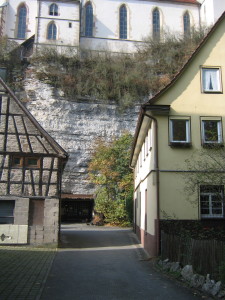
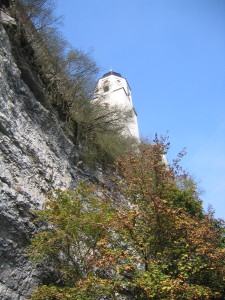
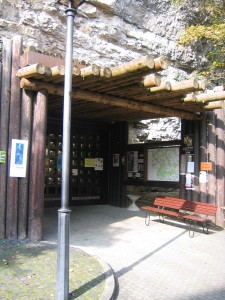
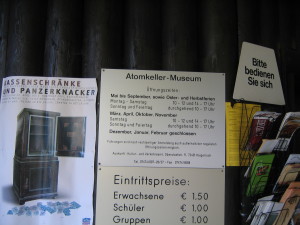
Above are a number of bios on display of the top German physicists
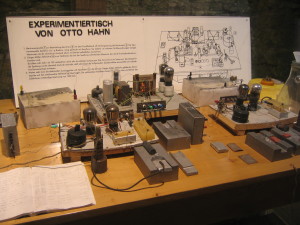
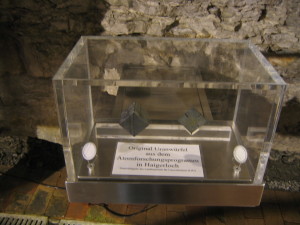
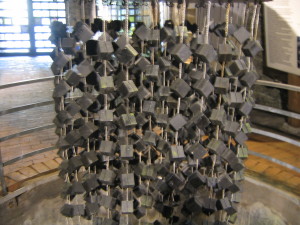
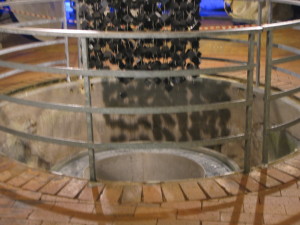
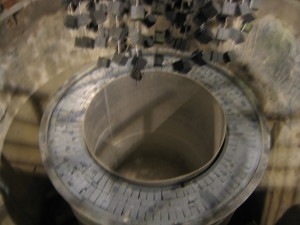
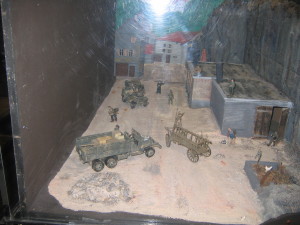
Author’s Note:
When I began writing this article I had no idea how complicated it was going to be.
In the space of a single human lifetime, humanity went from very little understanding of what makes up an atom to splitting that atom in a weapon of unimaginable power. In the lifetime’s of Ernst Rutherford, who first theorized and then proved that atoms have their charge concentrated in a very small nucleus, and Albert Einstein, whose general and special theories of relativity form the foundation of modern physics, the world changed in a profound way. If there was a golden age of theoretical physics, this was it.
Since this author only understands about 0.5% of the physics behind an atomic bomb, it was very difficult to explain it in such a way that even I could understand it let alone convey the subject matter in such a way so that the reader wouldn’t be disgusted with my inability to explain it simply. I hope I haven’t failed. I probably failed. Ha.
I visited Haigerloch in 2007, purely by accident. I had been in Stuttgart for a conference and was going to spend the weekend in Friedrichshafen on the Bodensee to visit Graf Zeppelin’s incredible Zeppelin Museum. I was digging around on the Internet for places to stop along the way when I remembered reading an article about the Atomkeller Museum in Haigerloch on the edge of the Black Forest. It turned out to be very interesting if not totally devoid of other tourists. The museum was open and the ticket taker, dutifully collected my 1.5 Euro entrance fee. I asked how many people visited in a year. He laughed.
